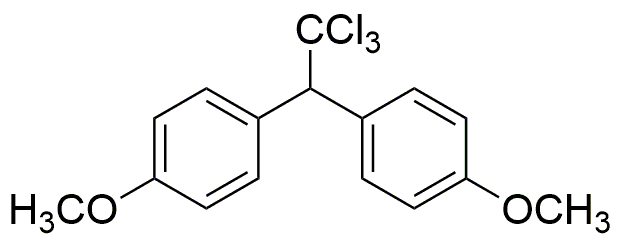Methoxychlor is widely utilized in research focused on:
- Agricultural Applications: It serves as an effective pesticide, particularly for controlling pests in crops. Its ability to target a wide range of insects makes it valuable for farmers looking to protect their yields.
- Environmental Studies: Researchers use methoxychlor to study its effects on ecosystems, particularly in aquatic environments. This helps in understanding the chemical's impact on wildlife and water quality.
- Endocrine Disruption Research: Methoxychlor is often examined for its potential to disrupt hormonal systems in animals. This research is crucial for assessing risks to human health and wildlife.
- Formulation Development: In the pharmaceutical industry, it can be used as a model compound in the development of new drugs, particularly those targeting hormonal pathways.
- Comparative Toxicology: Methoxychlor is utilized in toxicology studies to compare its effects with other pesticides, aiding in the development of safer alternatives for pest control.
General Information
Properties
Safety and Regulations
Applications
Methoxychlor is widely utilized in research focused on:
- Agricultural Applications: It serves as an effective pesticide, particularly for controlling pests in crops. Its ability to target a wide range of insects makes it valuable for farmers looking to protect their yields.
- Environmental Studies: Researchers use methoxychlor to study its effects on ecosystems, particularly in aquatic environments. This helps in understanding the chemical's impact on wildlife and water quality.
- Endocrine Disruption Research: Methoxychlor is often examined for its potential to disrupt hormonal systems in animals. This research is crucial for assessing risks to human health and wildlife.
- Formulation Development: In the pharmaceutical industry, it can be used as a model compound in the development of new drugs, particularly those targeting hormonal pathways.
- Comparative Toxicology: Methoxychlor is utilized in toxicology studies to compare its effects with other pesticides, aiding in the development of safer alternatives for pest control.
Documents
Safety Data Sheets (SDS)
The SDS provides comprehensive safety information on handling, storage, and disposal of the product.
Product Specification (PS)
The PS provides a comprehensive breakdown of the product’s properties, including chemical composition, physical state, purity, and storage requirements. It also details acceptable quality ranges and the product's intended applications.
Certificates of Analysis (COA)
Search for Certificates of Analysis (COA) by entering the products Lot Number. Lot and Batch Numbers can be found on a product’s label following the words ‘Lot’ or ‘Batch’.
*Catalog Number
*Lot Number
Certificates Of Origin (COO)
This COO confirms the country where the product was manufactured, and also details the materials and components used in it and whether it is derived from natural, synthetic, or other specific sources. This certificate may be required for customs, trade, and regulatory compliance.
*Catalog Number
*Lot Number
Safety Data Sheets (SDS)
The SDS provides comprehensive safety information on handling, storage, and disposal of the product.
DownloadProduct Specification (PS)
The PS provides a comprehensive breakdown of the product’s properties, including chemical composition, physical state, purity, and storage requirements. It also details acceptable quality ranges and the product's intended applications.
DownloadCertificates of Analysis (COA)
Search for Certificates of Analysis (COA) by entering the products Lot Number. Lot and Batch Numbers can be found on a product’s label following the words ‘Lot’ or ‘Batch’.
*Catalog Number
*Lot Number
Certificates Of Origin (COO)
This COO confirms the country where the product was manufactured, and also details the materials and components used in it and whether it is derived from natural, synthetic, or other specific sources. This certificate may be required for customs, trade, and regulatory compliance.

